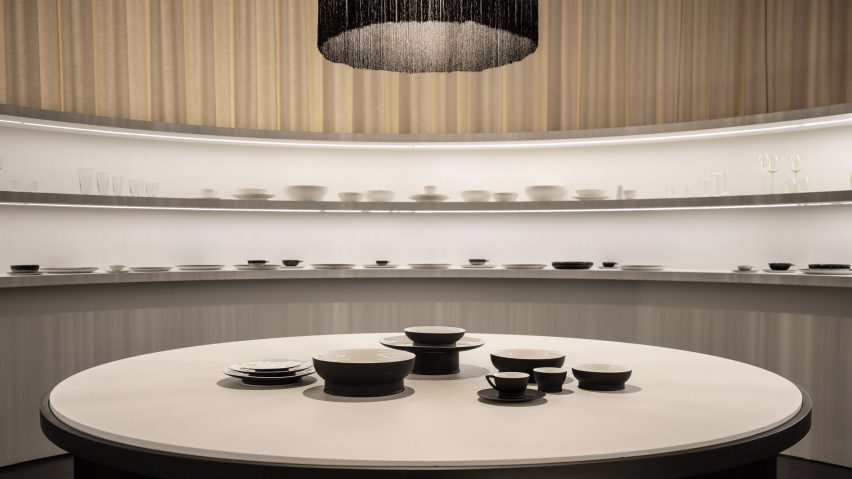Belgian fashion designer Ann Demeulemeester has produced her first homeware and lighting collection, which launched at Maison&Object furniture fair in Paris this week.
Ann Demeulemeester – who until six years ago headed up her eponymous fashion brand – joined forces with Belgian furniture and homeware brand Serax to launch two collections of porcelain tableware, glassware, cutlery.
The launch also included two lighting collections for the design brand.
"Everybody was very curious about my next step, so I wanted it to be bold. I couldn't just design one bowl," Demeulemeester told Dezeen.
Together with her husband Patrick Robyn, the designer made each porcelain prototype for the wide-ranging collection herself in a studio in a backroom of her home in the Belgian countryside.
She has transformed the space into a fully equipped porcelain atelier.
"We are makers. Whether it is clothing, furniture, vegetables or dinner plates, we have the tendency to design and produce whatever we need around the house," Demeulemeester said.
The designer developed the tableware after years of individual training and experimenting with porcelain. The Dé collection comprises four sizes of dinner plate, five sizes of bowl, espresso cups, regular cups and a milk jug.
"It was the most complicated collection we have ever produced," said CEO of Serax, Axel Van den Bossche.
The brand has previously made tableware with Vincent Van Duysen, Paola Navone, Piet Boon and Roos van de Velde amongst others.
Each item is decorated with black or red brush strokes that create a "chiaroscuro" effect on the tableware.
"For the delicate brush strokes lining the Dé plates, I made a video tutorial to show the artisans in China how it is being done," said Demeulemeester. "Every one of those plates is painted by hand and therefore unique."
The cutlery, called Zoe, comes in four finishes: matte black stainless steel, matte anthracite stainless steel, polished stainless steel and polished silver-plated stainless steel.
Each item has a distinctive pointed shape, with the faceted shape of the handles created by hand, in order to reflect light unevenly.
Demeulemeester drew illustrated mock-ups of every glass in the collection, as if they were fashion silhouettes. The collection includes water glasses, champagne coupes and flutes, wine glasses and tumblers in clear and green glass, in a variety of styles.
"We were inspired by the historic uranium glassware produced between 1870 and 1940. Together with Serax we searched for a procedure to come as close to that colour as possible without using the radioactive uranium," said Demeulemeester.
"For me it was also a statement to show that I can do more than just black and white."
The second collection of tableware is called Ra, and comprises a full dinner service with a cake stand. Like the glassware, it comes in green, as well as white porcelain and in a version with a black exterior.
Following on from the two tableware collections, Demeulemeester and her husband started experimenting with porcelain ribbons to create lighting. To do so, the ribbons needed to be as thin as possible.
"It was a huge challenge, with a lot of trial-and-error," said the designer.
"But when we first lit a lamp surrounded by a porcelain ribbon waterfall, the result was pure poetry. Maybe even more important than the light they produce is the shadows these lamps create," she continued.
The two lighting collections includes a cube-shaped table lamp with porcelain sides, as well as a curved pendant, wall and floor lamb with an ombre design made from thousands of hand knotted viscose threads.
"The impact of these lamps on their surroundings is almost cinematic," said the designer.
Demeulemeester has also designed floor and pendant lamps that feature a porcelain disc with prominent black electric cord and fittings.
A first prototype of one of the lamps was displayed in the family's guest room and led to the creation of five further lighting fixtures. In total the collections comprise more than ten different designs.
Demeulemeester graduated from the womenswear design course at the Royal Academy of Fine Arts in Antwerp in 1981.
With classmates Walter Van Beirendonk, Dries Van Noten, Marina Yee, Dirk Van Saene and Dirk Bikkembergs, she attended London Fashion Week in 1986, where they were named The Antwerp Six.
She later opened Ann Demeulemeester flagship stores in Tokyo and Hong Kong, as well as in her native Belgium. Demeulemeester announced her departure from her fashion house in 2013.
"The breakneck pace of the industry was suffocating me. Moreover I always liked the idea of translating my creativity into another discipline," she explained.
"I love the feeling of silently creating with my own bare hands. The loneliness of this process feels very liberating," she continued.
Last year, graduate fashion designer July Londono created a collection called Homeware that was designed not only to be worn, but also to function as home accessories like tablecloths, chair covers and bathroom towels.
The garments were designed to be left on show, literally as part of the furniture.

